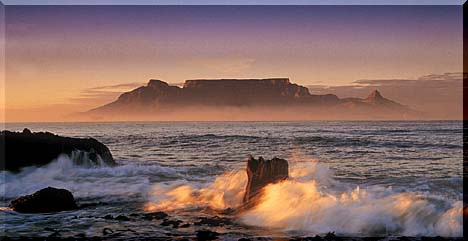
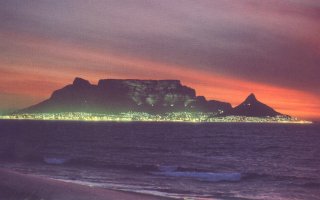
Cape Town by Night
Lights of the City beneath the imposing International Landmark of 1076m Table Mountain flanked by Devil's Peak at left and Lion's Head at right - from accross the waters of Table Bay.


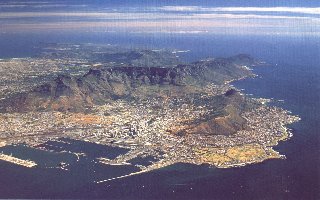
The Cape Peninsula The wonder world of beauty, history and splendour - Table Mountain, the Harbour and City, Sea Point, Hout Bay, Cape Point, Simonstown and the Southern Suburbs |
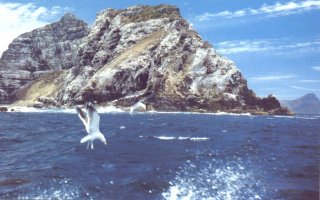
Cape Point The rocky headland of Africa where two of the most powerful oceans meet |
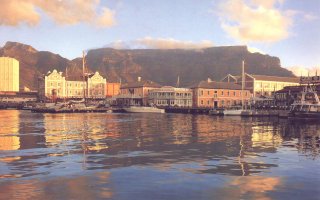
Victoria and Alfred Waterfront Clouds above Table Mountain........beneath the colourful waterfront and harbour reflections with reminders of the marine past mingling with entertainment for the City and its visitors. |
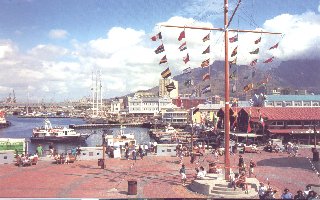
Victoria and Alfred Waterfront Cape Town's most interesting tourist attraction. . . . |
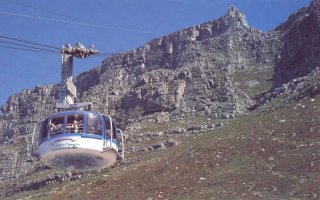
Table Mountain by Cable Car . |
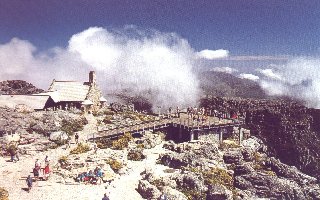
Table Mountain View site and restaurant atop the mountain. |
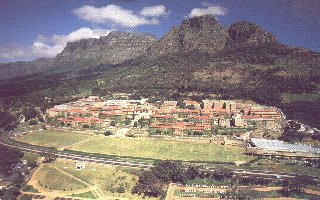
A view of the University of Cape Town on the lower slopes of Devil's Peak |
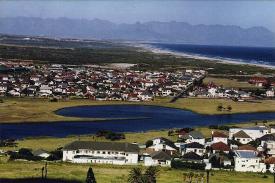
A view of Muizenberg with the False Bay coast line and Hottentots Holland Mountain. |
Cape Town, Africa's southern jewel, is more than just a tourist paradise offering exquisite beauty, flawless beaches, and a backdrop of awesome table mountain towering over the the vibrant metropolis at its foot. It is a place of historical riches and diverse cultures and people that date back to the seventeenth century. Cape Town is a unique city, often called one the most beautiful in the world. As South Africa's mother city Cape Town has a special place in the hearts of South Africans and the many visitors that arrive on these shores every year to enjoy the unique views and vibrant energy that Cape Town offers.
PROFILE OF CAPE TOWN
At midday the noon gun booms out over Cape Town, startling the pigeons into a flurry of wings in Greenmarket Square, and old Cape Town residents glance at their watches to check the time. It's a ritual that has lost its meaning in a world of digital watches and radio time-signals, but it is very much part of the changeless traditions of Cape Town, South Africa's oldest and most beautiful city.
In more leisurely times, tramcors and hansom cabs carried
passengers along Adderley Street. Today there are no rock-breaking convicts
in the harbour to sigh with relief and straighten their aching backs
at the noon-day lunch signal. But Cape Town without the noon gun would
be unthinkable. Time was vitally important to the sea captains of old who
called in at Table Bay in the days of the three-masted sailing
ships. They relied on such time checks in order to adjust the chronometers
necessary for navigation. As part of the service provided at the
harbour, a 'time ball' was constructed on the hill above the
Table Bay Docks to signal the hour of one o'clock.
It is still in action today. For the early European navigators to the Cape,
there were no such services at all, of course. They sailed into Table Bay
after months at sea, in desperate need of provisions such as fresh water
and meat, and wood for their galley stores. They were met by small,
yellow-skinned people who spoke in a strange, cricking manner and who were
nicknamed hottentotten, meaning 'the stutterers', by the Dutch. These little
people of the Cape traded cattle and sheep for iron knives, cooking pots
and beads. After the establishment of the refreshment station at the Cape
in 1652, voyagers also stocked up on supplies of Cape fruit and vegetables.
And for more than three centuries, the Cape has continued to provide for
the needs of visitors from all parts of the world, making it truly worthy
of its title of 'Tavern of the Seas'.
The early history of the Cape is lost, for the simple reason that the first inhabitants did not leave any records, the only clues to their existence being rock paintings which tell us little about them. Although archaeologists can piece together a picture of life at the Cape before European invasion, it is sketchy and, for the most part, inaccurate. This picture is of people ,who roamed the beaches - strandlopers - gathering food from the sea. There is also evidence of people inland who herded animals across large areas. They built nopermanent houses and set up no towns. The Cape was also inhabited by wild animals no longer found here today: lions, elephants, hippos, rhino and buffalo. All have long since vanished in the wake of what we like to call 'civilization'.
TABLE MOUNTAIN
The old part of Cape Town lies in a great amphitheatre formed by the rocky sandstone masses of Table Mountain, Devil's Peak and Lion's Head. The mountain looms over the city, embracing it and providing Cape Town with a unique setting and character. Devil's Peak, to the left of the mountain when looking up from the city, gets its name from the legend of Van Hunks, the pirate, who met the Devil there for a smoking contest. As the two great smokers puffed their pipes, they formed the white tablecloth of cloud that is a regular feature of the mountain when the Cape southeaster blows. Lion's Head, at the other end of the mountain, might have been named because there were lions roaming there, but was more likely given its name simply because it looks rather like a lion, with the curved back and rump ending at Signal Hill, above Green Point,
On summer evenings powerful floodlights bathe the stone
ramparts of the mountain in an eery blue light. In winter the slopes
glisten with rain and mountain streams roar down the many narrow ravines,
often carrying mudslides and trees in their path.
Hundreds of millions of years ago, when the Cape was
part of the super- continent geologists call Gondwana, the feature that
is now Table Mountain was a flat, empty plain. As the vast land-mass shifted
and heaved, the plain slowly subsided under the sea. For 50 million years
fine sediment built up, layer after layer. Then the earth's plates buckled
again and the layers of sediment were thrust upward, first as an island
and then, as the glaciers of the ice age tore and carved the solid mass,
as what we now know as Table Mountain, Devil's Peak and Lion's Head. The
layers of ancient submarine sediment can still be seen as horizontal lines
across the face of the mountain.
More recently, the mountain and surrounding areas were the home of a rich variety of wild animals. Lions roamed the mountains, hippos wallowed in the swampy areas on the flats beneath the mountain. Most of the larger animals of Africa were found here, with one possible exception: the low fynbos vegetation was too short for giraffes.
Today almost all the wild animals have disappeared as man has encroached on their habitat. Only the smaller ones remain on the mountain - the little grysbok, porcupines, tortoises and the ubiquitous dassies, or rock rabbits.
An interesting addition to the mountain fauna is the Himalayan tahr. A pair of these animals, originally from the Himalayan mountains in northern India, escaped from the Groote Schuur Estate zoo in the 1930s and settled happily on Table Mountain. Today, only a handful of these shy, goat-like animals live on the mountain. The flora of the mountain is richly varied, with more than 500 species of erica and 100 species of iris. Botanists have long been fascinated by the incredibly wide variety of the Cape flora and estimate that more than 10000 plant species are found here. They range from regal proteas to minute, ground-hugging ferns. Most of these occur on Table Mountain. The red disa, aptly dubbed the Pride of Table Mountain, grows in the cool, damp valleys in a number of places on the mountain and bears its flowers in January and February.
No visit to Cape Town is complete without a trip to the top of Table Mountain. All year round, queues of sightseers wait for their turn to travel in a swaying cable car on one of the most spectacular rides in the world. The view from the top, 1 067 metres above the sea, is breathtaking, whether one is looking over the city bowl and further to Table Bay or over the 'back' part of the mountain across the Twelve Apostles to the Atlantic ocean beyond Clifton and Camps Bay beaches.
The cableway is a two-car service that has been in operation for more than 60 years without a single accident. This is in part due to the interesting three-cable system by which it operates. The main cable carries the weight of the car, a thinner one pulls the cars along, and a third cable is there purely as a back-up; in fact, this cable has never been used. The two cars counter-balance each other, one making the upward journey while the other travels back down. The cableway operates on a daily basis weather permitting, and should the weather change for the worse, visitors are alerted to make their way back by means of a siren at the upper cable station. There are hundreds of footpaths along the mountain's slopes and to thetop for energetic hikers, as well as easy-to follow rambles on the summit, marked with animal silhouettes. However, utmost care must be taken when walking - the benign- looking giant of Table Mountain has a nasty streak and has claimed the lives of several people during the past 10 years. At the top of the mountain there is a souvenir shop, a post office where visitors can buy postcards and have them franked with a special Table Mountain postmark, and a rustic stone restaurant which serves light meals and refreshments. The summit is also a popular spot for picnics which are invariably interrupted by the fat, little rock rabbits - or dassies - some of which have become so tame that they will allow tourists to tickle them.
From the flat summit of Table Mountain the first-time visitor will get a better idea of the often confusing geography of this crooked finger of rock jutting into the stormy Atlantic Ocean, and of the layout of the city at its base. To the north and west is the vast expanse of ocean broken only by pin-point islands such as Gough and Tristan da Cunha between the Cape and South America.
Directly in front of the mountain is Table Bay with the notorious Robben Island in its centre. This little island has a sorry history of use as a jail for political prisoners, the most famous of whom was Nelson Mandela. Its future is undecided as the country heads into an age of change. Robben Island is populated by prison officials and their families, and although there are few prisoners there now, a high-security ferry still completes the voyage to and from the mainland every few hours.
The view of Table Mountain most often captured on postcards and popular paintings is the one from Bloubergstrand on the northern side of Table Bay. From here the three parts of Table Mountain - Lion's Head, 'the table', and Devil's Peak - can be most clearly seen.
With Table Mountain as a backdrop, the long, sandy beach at Blouberg provides a spectacular spot for a seaside picnic. Blouberg - or Blaauwberg in the original Dutch spelling - for many years consisted of just a handful of holiday shacks and fishermen's cottages dotted along the beachfront. It was a remote spot where anglers could be alone to cast their lines through pounding surf, or relax with a soothing bottle of good Cape wine and watch the sun set over the sea. Today, Blouberg is a fast-growing 'dormitory suburb' where rows of townhouses and large blocks of flats offering 'spectacular ocean views' are springing up like mushrooms.
To the south-east of the mountain is the wide expanse of level sandy land known as the Cape Flats. The greater part of this area is given over to low-income housing and industrial developments. Other, large parts of the Cape Flats are home to hundreds of thousands of black people who have been driven to the city from unproductive rural land in search of employment. They erect their make shift homes from any material they can find, and so create the sprawling cities of plastic, wood and corrugated iron. These stand in sharp contrast to the more affluent 'white' suburbs of Cape Town with their gracious homes, shaded gardens, sports clubs and fine traditional schools.
From the stone restaurant at the top of the mountain, visitors look down on the pretty suburbs of Clifton and Camps Bay, where blocks of flats hug the seaside rocks and a series of sandy beaches provide sheltered swimming places. Further along to the south is the winding Marine Drive that takes travellers along the coast to Hout Bay past the row of buttress peaks known as the Twelve Apostles.
To make things easier for first-time visitors to the Cape, a detailed relief map has been set up on the mountain top, and this has helped thousands of people to unravel the puzzle of the Peninsula.
 Return
to Home Page
Return
to Home Page